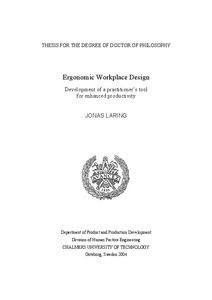Ergonomic workplace design : development of a practitioner’s tool for enhanced productivity
"There is a lack of pragmatic methods to assess musculoskeletal load risks when planning for production when there is no human operator to observe that performs the tasks. Existing methods are generally either expensive computer manikin software that is complicated to learn and use, simple digi...
| Main Author: | |
|---|---|
| Institution: | ETUI-European Trade Union Institute |
| Format: | TEXT |
| Language: | English |
| Published: |
Chalmers University of Technology
2004
|
| Subjects: | |
| Online Access: | https://www.labourline.org/KENTIKA-19138600124919568829-ergonomic-workplace-design-dev.htm |
| Summary: | "There is a lack of pragmatic methods to assess musculoskeletal load risks when planning for production when there is no human operator to observe that performs the tasks. Existing methods are generally either expensive computer manikin software that is complicated to learn and use, simple digital human models for static and episodic analysis best used by trained ergonomists or methods in need of full-scale prototypes for observation.
The suggested method in this report is intended to be used by production engineers who are interested in ergonomics and involved in pre-production planning. The ideal situation is when there is room for changes in both product and workplace design, the ambition exists to achieve high productivity and the insight exists that this is best accomplished when the designs are optimized over both production time and operator load.
A concept of a complete tool is sketched, incorporating a simple CAD tool for workplace design, a language to describe the intended tasks to be carried out and a knowledge based system for prompting the operator for needed input data and for analysis of the expected musculoskeletal load. ..."
(From the author's abstract) |
|---|---|
| Physical Description: | 49 p. Digital |

